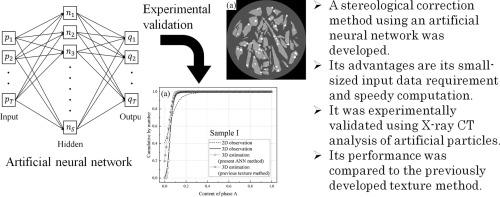当前位置:
X-MOL 学术
›
Miner. Eng.
›
论文详情
Our official English website, www.x-mol.net, welcomes your
feedback! (Note: you will need to create a separate account there.)
A stereological correction method employing an artificial neural network for mineral liberation assessment of ore particles
Minerals Engineering ( IF 4.9 ) Pub Date : 2020-10-01 , DOI: 10.1016/j.mineng.2020.106578 Takao Ueda , Tatsuya Oki
Minerals Engineering ( IF 4.9 ) Pub Date : 2020-10-01 , DOI: 10.1016/j.mineng.2020.106578 Takao Ueda , Tatsuya Oki

|
Abstract Mineral liberation and surface exposure, which are important features of processing crushed ore particles in minerals, are generally assessed in terms of cumulative distributions (such as volumetric composition distribution). These distributions are, however, distorted by stereological bias when they are determined by two-dimensional methods such as microscopy or by scanning electron microscopes or energy dispersive X-ray based analyzers. Thus, in the present study, a stereological correction method using an artificial neural network (ANN) was developed. Through preliminary and parametric investigation of the ANN, the network was designed with 12 neurons in each of the input and output layers, and 400 neurons in a hidden layer, using distribution bin-frequencies as the input and output parameters. Particle models exhibiting 17,630 different patterns of internal mineral structure and particle shape were computed and used as training data for the ANN, and a high training level, with a correlation coefficient over 0.999, was obtained. Then, experimental validation was conducted using two- and three-dimensional data obtained by X-ray computed tomography involving artificial bi-phase particles. The method showed very high stereological correction performance in the case of samples that were well approximated by the computed training data, but lesser performance in the case of an unexpected sample distribution. In addition, through comparison with the authors’ previously developed texture method, the advantages and disadvantages of the proposed ANN method are discussed.
中文翻译:

一种采用人工神经网络的体视校正方法进行矿石颗粒的矿物解离评估
摘要 矿物释放和表面暴露是处理矿物中碎矿颗粒的重要特征,通常根据累积分布(例如体积组成分布)进行评估。然而,当这些分布通过二维方法(例如显微镜)或通过扫描电子显微镜或基于能量色散 X 射线的分析仪确定时,会因体视偏差而扭曲。因此,在本研究中,开发了一种使用人工神经网络 (ANN) 的体视校正方法。通过对 ANN 的初步和参数研究,网络被设计为在每个输入和输出层有 12 个神经元,在隐藏层有 400 个神经元,使用分布 bin 频率作为输入和输出参数。粒子模型展示 17, 计算了 630 种不同的内部矿物结构和颗粒形状模式,并将其用作 ANN 的训练数据,获得了高训练水平,相关系数超过 0.999。然后,使用通过涉及人工双相粒子的 X 射线计算机断层扫描获得的二维和三维数据进行实验验证。该方法在计算训练数据很好地近似的样本的情况下表现出非常高的立体校正性能,但在意外样本分布的情况下表现较差。此外,通过与作者先前开发的纹理方法的比较,讨论了所提出的人工神经网络方法的优缺点。
更新日期:2020-10-01
中文翻译:

一种采用人工神经网络的体视校正方法进行矿石颗粒的矿物解离评估
摘要 矿物释放和表面暴露是处理矿物中碎矿颗粒的重要特征,通常根据累积分布(例如体积组成分布)进行评估。然而,当这些分布通过二维方法(例如显微镜)或通过扫描电子显微镜或基于能量色散 X 射线的分析仪确定时,会因体视偏差而扭曲。因此,在本研究中,开发了一种使用人工神经网络 (ANN) 的体视校正方法。通过对 ANN 的初步和参数研究,网络被设计为在每个输入和输出层有 12 个神经元,在隐藏层有 400 个神经元,使用分布 bin 频率作为输入和输出参数。粒子模型展示 17, 计算了 630 种不同的内部矿物结构和颗粒形状模式,并将其用作 ANN 的训练数据,获得了高训练水平,相关系数超过 0.999。然后,使用通过涉及人工双相粒子的 X 射线计算机断层扫描获得的二维和三维数据进行实验验证。该方法在计算训练数据很好地近似的样本的情况下表现出非常高的立体校正性能,但在意外样本分布的情况下表现较差。此外,通过与作者先前开发的纹理方法的比较,讨论了所提出的人工神经网络方法的优缺点。











































 京公网安备 11010802027423号
京公网安备 11010802027423号